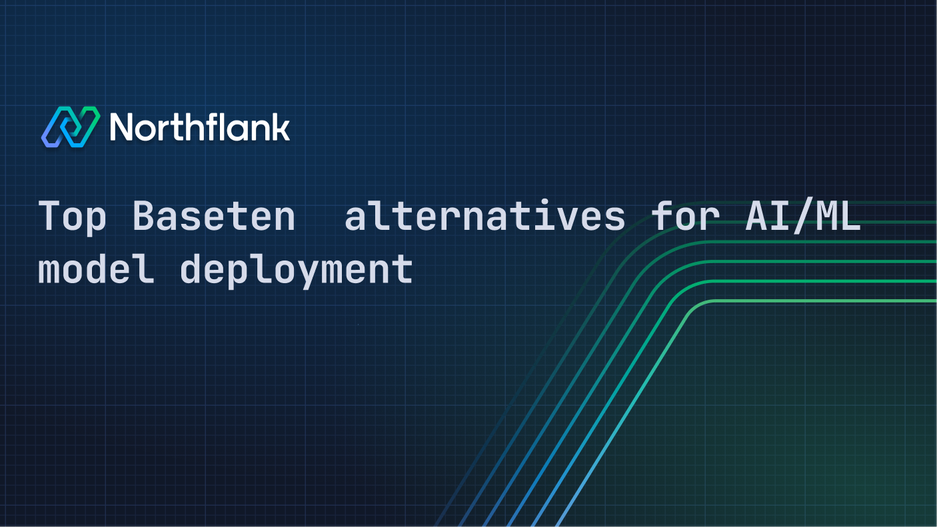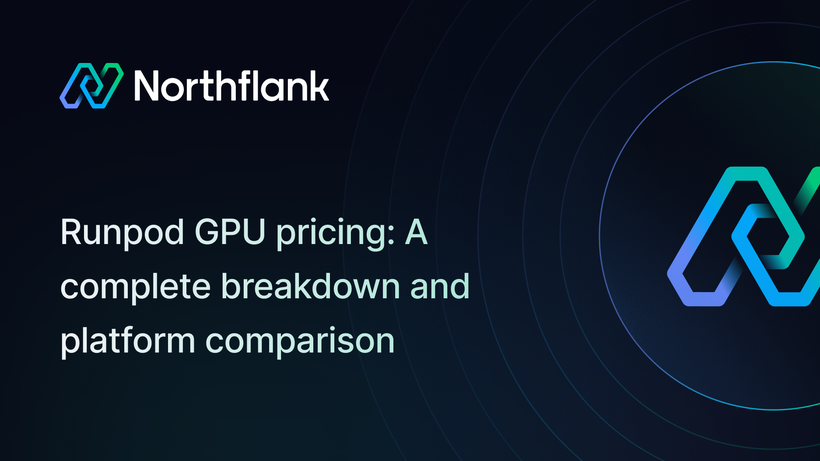

Top Baseten alternatives for AI/ML model deployment
You’ve trained the model. It works. Maybe it’s even pushing the state of the art.
Now comes the hard part: getting it into production.
Baseten makes that feel easy. You get model hosting, GPU support, a simple UI, and APIs, no Docker, no Kubernetes.
For a lot of teams, it's a great first step.
But once you try to scale, the cracks start to show. Cold starts. Custom dependencies. Creeping costs. Limited control.
That’s probably why you’re here, looking for something better suited to how you actually build.
The good news? You’ve got options.
In this guide, we’ll break down the best Baseten alternatives in 2025, compare their strengths, and help you figure out which one fits your stack.
This isn’t a sales pitch. It’s a guide for devs building production-ready ML products.
If you're short on time, here’s a snapshot of the top Baseten alternatives. Each tool has its strengths, but they solve different problems, and some are better suited for real-world production than others.
| Platform | Best For | Quick Take |
|---|---|---|
| Northflank | Full-stack ML apps with DevOps-grade flexibility | GPU containers, Git-based CI/CD, AI workload support, BYOC, and enterprise-ready features |
| Modal | Serverless Python workflows | Great for async-heavy workloads, scales to zero, no infrastructure needed |
| Replicate | Sharing public ML models easily | Ideal for demos and generative models, with public API hosting |
| RunPod | Cheap on-demand GPU compute | BYO Docker and runtimes, good for experiments and custom inference |
| SageMaker | Enterprise MLOps at scale | Deep AWS integration, supports full training and deployment lifecycle |
| Ray Serve | Custom model routing and orchestration | Flexible serving, supports DAGs, but requires infra setup |
⚡️ Pro tip: If you're building a production-ready product and need a balance between flexibility, performance, and developer experience, Northflank offers a modern, production-ready path without the platform lock-in. Click here to try it free, or book a demo here.
Baseten has found its sweet spot with Python developers and data scientists who want to deploy models fast, without wrestling with infrastructure.
Here’s what makes it click:
-
Fast, frictionless model deployment
You can turn a PyTorch, TensorFlow, or scikit-learn model into a live API in minutes. No Dockerfiles, no Kubernetes, no YAML.
-
Out-of-the-box UI support
With built-in Truss tooling and simple UI templates, you can wrap your model in a frontend without writing any JavaScript, perfect for internal tools, demos, or lightweight apps.
-
Managed GPU infrastructure
Baseten handles GPU provisioning, autoscaling, and lifecycle management behind the scenes. You focus on inference, not infra.
-
Straightforward pricing
Transparent, usage-based billing with no upfront commitment. Ideal for prototypes, side projects, or early-stage startups.
-
Batteries included
Background jobs, scheduled tasks, observability tools, and a built-in data store come bundled, so you don’t have to wire up extra services just to get going.
For individual developers or small teams without dedicated DevOps support, Baseten offers a smooth path from notebook to API. You can get to production quickly, and the platform mostly stays out of your way.
Of course, the trade-off with any platform like this is control, and that’s where many teams eventually start to feel constrained.
Why teams eventually outgrow Baseten
Baseten is great for deploying your first model. But if you're building a production-ready product where latency, cost, security, and full-stack infra matter, you'll start running into limits. That’s where platforms like Northflank come in.
Baseten is a great starting point for shipping models quickly, but as your project grows, it can start to show its limits. Here’s where teams often hit friction:
Baseten doesn’t let you bring your own Docker image or control the environment deeply. That’s fine if your model runs on standard packages, but it becomes a headache the moment you need something custom, a private dependency, a system lib, or a non-Python service. Platforms like Northflank give you deep control over your container environment, and even let you run untrusted AI-generated code safely via secure runtime isolation, critical for teams deploying fine-tuning jobs, LLMs, or customer-specific code.
What Baseten gives you in convenience, it can cost you in latency. Cold starts and warm-up times can add unexpected delays, especially under load. If you're building something latency-sensitive, say, a real-time API, you may end up optimizing around the platform instead of your product.
Baseten doesn’t offer a self-hosted option unless you're a big enterprise customer. That means no transparency into the platform, and no way to run it in your own environment. For teams that prioritize ownership, compliance, or long-term control, this can be a significant blocker.
It’s cost-effective at a small scale, but once you start serving real traffic or running heavier models, pricing becomes hard to predict, especially if you're running multiple models with GPU requirements. You might find yourself optimizing for cost instead of user experience.
Baseten has a CLI and some GitHub-friendly workflows, but it lacks the depth of integration that modern teams expect. You can’t fully wire it into your deployment pipeline, test environment, or preview builds. Platforms like Northflank are built with Git-based CI/CD at their core.
Baseten runs in its own managed cloud by default. They do support Bring Your Own Cloud through Self-hosted and Hybrid deployments, which let you run workloads in your own AWS, GCP, or Azure environment. However, these options are only available on enterprise plans and require working directly with their team. That can be a challenge for teams that want to get started quickly without going through a sales process.
In contrast, Northflank lets you bring your own cloud from the beginning with a fully self-serve setup and no need to talk to sales.
Before switching platforms, it’s important to think beyond checkboxes. What looks simple today can turn into friction tomorrow if you don’t have the right building blocks. Here’s what to seriously evaluate when considering an alternative to Baseten:
Can you control the serving environment? If your model needs custom dependencies, non-Python services, or GPU-accelerated libs, managed runtimes might not cut it. You’ll want full container-level control — and ideally, the ability to bring your own image.
With platforms like Northflank, you can deploy any container, not just models, so your runtime is exactly what your app needs. No workarounds. No black boxes.
If you're deploying real-time APIs, latency matters. Cold starts, provisioning lag, and inconsistent scaling can break the user experience, especially for LLMs or vision models.
Look for platforms that let you keep containers warm, scale to zero when idle, and autoscale under load, all with GPU support. Northflank gives you fine-grained control over autoscaling and lets you keep hot replicas running, without paying premium prices.
The best deployment workflows match your team’s habits. Whether you’re a solo developer using CLI commands or a larger team pushing to staging via Git, you shouldn’t have to change how you work.
Git-based deploys, PR previews, CLI tools, and APIs should all be part of the story. Northflank, for example, supports GitHub-native workflows out of the box, perfect for tight CI/CD pipelines.
Not every ML model is just an API. Sometimes you need to ship a product, whether it’s a dashboard, an internal tool, or a fully interactive app. That means deploying both the frontend and backend together.
Many platforms silo inference from everything else. Look for alternatives that support full-stack deployment, not just model serving. Northflank lets you deploy Next.js, React, or any frontend framework alongside your database and APIs, all from the same repo, on the same platform.
Baseten’s usage-based pricing can spike as you scale, especially with GPU workloads. The right platform should let you control your cost structure, whether that means:
- predictable flat-rate containers
- cost-per-inference
- or autoscaling tuned to your real usage
Northflank gives you transparent pricing, and because you control your container runtime and scaling, you also control cost.
If you're building for finance, healthcare, or enterprise, compliance isn’t optional. Look for platforms that support SOC 2, HIPAA, GDPR, and secure audit logs, or at the very least, give you the ability to run in your own secure cloud.
Northflank is SOC 2-ready, it supports secure features like RBAC, audit logs, and SAML out of the box, all with multi-tenant isolation and BYOC.
Many teams don’t want to run models on someone else’s infrastructure. Whether it's for data residency, privacy, or integration with your existing stack, running in your own cloud can be critical.
Northflank supports BYOC natively to deploy into your own AWS, GCP, or Azure account without enterprise pricing or sales calls.
Manual deploys don’t scale. Look for platforms that treat CI/CD as a first-class feature. Git-based deploys, automated rollbacks, staged environments, and secrets management should be built-in, not bolted on.
Northflank was designed with modern DevOps in mind, including Git triggers, environment previews, and built-in CI integrations.
Here is a list of the best Baseten alternatives you can find. In this section, we talk about each platform in depth, its top features, Pros, and Cons.
Northflank isn’t just a model hosting tool; it’s a production-grade platform for deploying and scaling AI products. It combines the flexibility of containerized infrastructure with GPU orchestration, Git-based CI/CD, and full-stack app support.
Whether you're serving a fine-tuned LLM, hosting a Jupyter notebook, or deploying a full product with both frontend and backend, Northflank gives you everything you need, with none of the platform lock-in.

Key features:
- Bring your own Docker image and full runtime control
- GPU-enabled services with autoscaling and lifecycle management
- Multi-cloud and Bring Your Own Cloud (BYOC) support
- Git-based CI/CD, PR previews, and full-stack deployment
- Secure runtime for untrusted AI workloads
- SOC 2 readiness and enterprise security (RBAC, SAML, audit logs)
Pros:
- No platform lock-in – full container control with BYOC or managed infrastructure
- Transparent, predictable pricing – usage-based and easy to forecast at scale
- Great developer experience – Git-based deploys, CI/CD, preview environments
- Optimized for latency-sensitive workloads – fast startup, GPU autoscaling, low-latency networking
- Supports AI-specific workloads – LLMs, Jupyter, fine-tuning, inference APIs
- Built-in cost management – real-time usage tracking, budget caps, and optimization tools
Cons:
- No special infrastructure tuning for model performance.
Verdict: If you're building production-ready ML products — not just demos — Northflank gives you full control without platform lock-in. It's the only alternative purpose-built for both AI and traditional apps at scale, with cost efficiency, security, and developer velocity in mind.
Modal makes Python deployment effortless. Just write Python code, and it handles scaling, packaging, and serving — perfect for workflows and batch jobs.

Key features:
- Python-native infrastructure
- Serverless GPU and CPU runtimes
- Auto-scaling and scale-to-zero
- Built-in task orchestration
Pros:
- Super simple for Python developers
- Ideal for workflows and jobs
- Fast to iterate and deploy
Cons:
- Limited runtime customization
- Not designed for full-stack apps or frontend support
- Pricing grows with always-on usage
Verdict:
A great choice for async Python tasks and lightweight inference. Less suited for full production systems.
Replicate is purpose-built for public APIs and demos, especially for generative models. You can host and monetize models in just a few clicks.

Key features:
- Model sharing and monetization
- REST API for every model
- Popular with LLMs, diffusion, and vision models
- Built-in versioning
Pros:
- Zero setup for public model serving
- Easy to showcase or monetize models
- Community visibility
Cons:
- No private infra or BYOC
- No CI/CD or deployment pipelines
- Not built for fullstack ML apps all-in-one
Verdict:
Great for showcasing generative models — not for teams deploying private, production workloads.
RunPod gives you raw access to GPU compute with full Docker control. Great for cost-sensitive teams running custom inference workloads.

Key features:
- GPU server marketplace
- BYO Docker containers
- REST APIs and volumes
- Real-time and batch options
Pros:
- Lowest GPU cost per hour
- Full control of runtime
- Good for experiments or heavy inference
Cons:
- No CI/CD or Git integration
- Lacks frontend or full-stack support
- Manual infra setup required
Verdict:
Great if you want cheap GPU power and don’t mind handling infra yourself. Not plug-and-play.
SageMaker is Amazon’s heavyweight MLOps platform, covering everything from training to deployment, pipelines, and monitoring.

Key features:
- End-to-end ML lifecycle
- AutoML, tuning, and pipelines
- Deep AWS integration (IAM, VPC, etc.)
- Managed endpoints and batch jobs
Pros:
- Enterprise-grade compliance
- Mature ecosystem
- Powerful if you’re already on AWS
Cons:
- Complex to set up and manage
- Pricing can spiral
- Heavy DevOps lift
Verdict:
Ideal for large orgs with AWS infra and compliance needs. Overkill for smaller teams or solo devs.
Ray Serve is part of the Ray ecosystem — built for fine-tuned inference flows, multi-model routing, and real-time workloads.

Key features:
- DAG-based inference graphs
- Supports multiple models per API
- Fine-grained autoscaling
- Python-first APIs
Pros:
- Powerful for complex inference pipelines
- Good horizontal scaling across nodes
- Open source and flexible
Cons:
- Requires orchestration and infra setup
- Not turnkey — steep learning curve
- No built-in frontend or CI/CD
Verdict:
Perfect for advanced teams building composable model backends. Just be ready to manage the stack.
Your choice of Baseten alternative depends on your priorities:
| Need this | Best choice | Why it works |
|---|---|---|
| Best all-around for production | Northflank | Full Docker control, GPU autoscaling, Git CI/CD, frontend + backend deploys, and BYOC — all without lock-in. |
| Simple Python workflows | Modal | Fast serverless jobs, scales to zero, great for prototypes — but limited runtime flexibility. |
| Cheapest raw GPU compute | RunPod | BYO Docker with low-cost spot GPUs. Great for training or cheap inference — hands-on infra required. |
| Public-facing model demos | Replicate | Ideal for monetizing or sharing generative models — but not built for complex backends. |
| Enterprise MLOps | SageMaker | Deep AWS integration and compliance — heavyweight, but robust for large orgs. |
| Real-time, multi-model orchestration | Ray Serve | High-perf DAG-based inference — powerful, but complex to operate. |
Baseten is a great starting point for deploying models without dealing with infrastructure. But once your needs grow, its limits start to show.
If you need more control over runtime, better CI/CD, full-stack support, or flexible GPU deployment, there are stronger options out there. Platforms like Modal and RunPod are great for specific workflows, while SageMaker and Ray Serve suit enterprise and infra-heavy teams.
But if you're building production-ready ML products with real users and care about developer experience, cost control, and full flexibility, Northflank stands out. It gives you control of containers with the ease of modern DevOps.
Deploy your ML workloads with real CI/CD, BYOC, and GPU auto-scaling on Northflank. Start free and scale when you're ready.


